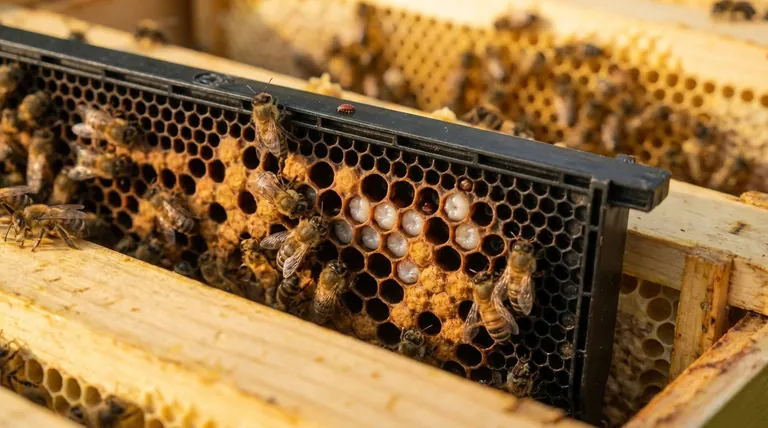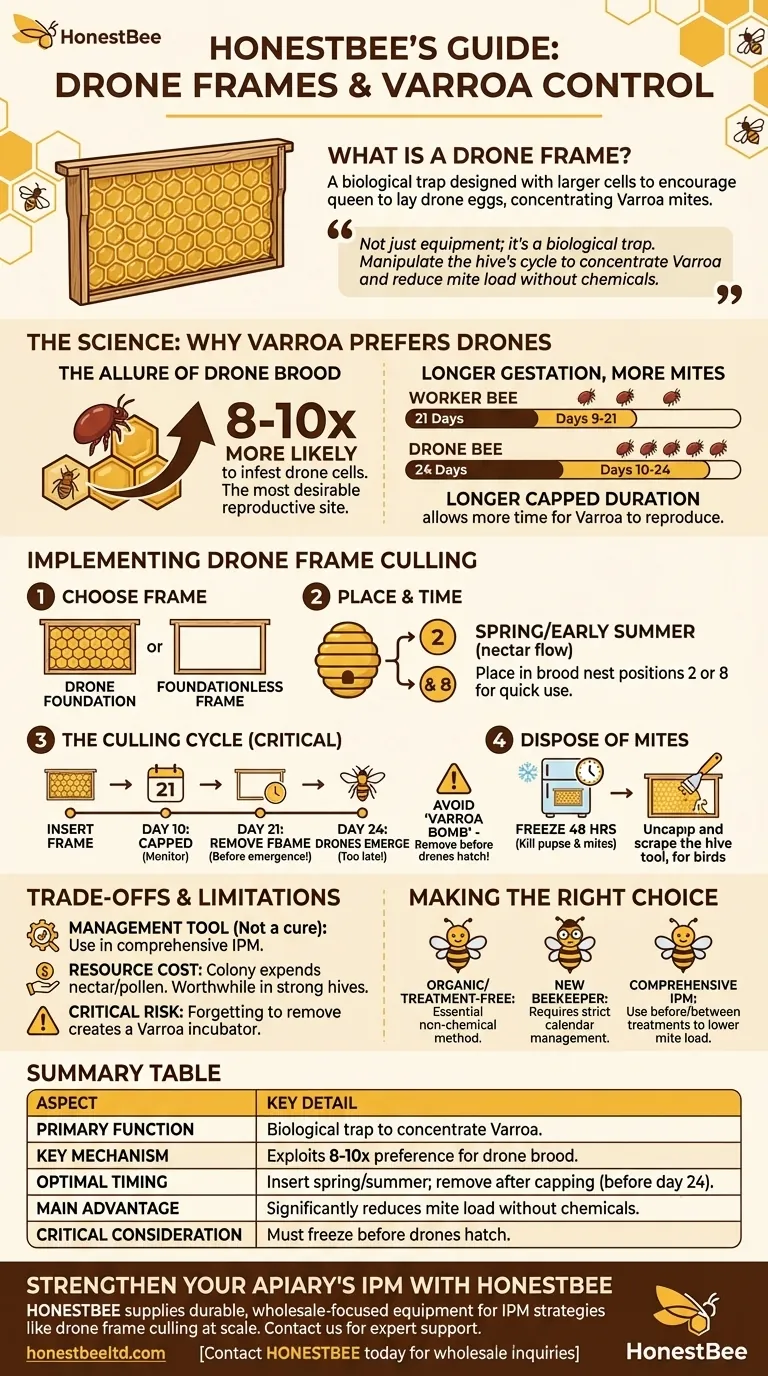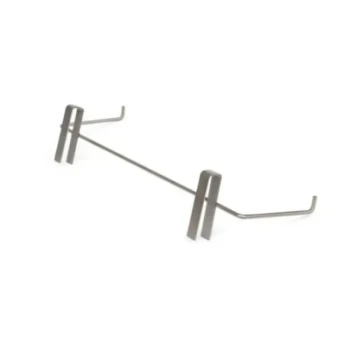At its core, a drone frame is a specialized tool used in beekeeping to exploit the reproductive cycle of the Varroa mite. These frames are designed with larger wax cells, which encourages the queen to lay unfertilized eggs that develop into male bees, or drones. Because Varroa mites have a strong preference for drone brood, the frame acts as a highly effective trap, concentrating the pests in a single, removable location.
A drone frame is not just a piece of equipment; it's a biological trap. By manipulating the hive's natural brood cycle, you can concentrate Varroa mites in a disposable location, significantly reducing the overall mite load without relying solely on chemical treatments.

The Science Behind the Trap: Why Varroa Prefers Drones
To use this tool effectively, you must first understand the biological preference that makes it work. Varroa mites are not randomly distributed throughout a hive; they make specific choices to maximize their own reproduction.
The Allure of Drone Brood
Varroa destructor mites are between eight and ten times more likely to infest a drone cell than a worker bee cell. This powerful attraction is the fundamental principle behind drone frame culling. The frame essentially becomes the most desirable location in the hive for the mites to reproduce.
Longer Gestation, More Mite Reproduction
A drone takes approximately 24 days to develop from egg to adult, compared to just 21 days for a worker bee. The critical period is the time the cell is capped.
Drone brood is capped for a longer duration, giving a female Varroa mite more time to lay eggs and for her offspring to mature. This longer cycle means one founding mite can produce more viable, mated daughters in a drone cell than she could in a worker cell.
How to Implement Drone Frame Culling
Proper timing and handling are critical to success. A mistake in this process can backfire, turning your trap into a mite factory.
Choosing Your Frame
You can use a frame with a specific drone foundation, which is plastic or wax stamped with larger, drone-sized cells. Alternatively, many beekeepers simply use a foundationless frame, as bees will naturally build drone comb in open spaces, especially during a population boom.
Placement and Timing
The ideal time to insert a drone frame is in the spring and early summer, during the main nectar flow when the hive is rapidly expanding. Place the frame within the brood nest, typically in position 2 or 8 of a 10-frame brood box. Placing it near existing brood encourages the queen to lay in it quickly.
The Culling Cycle: When to Remove the Frame
This is the most critical step. Once the bees have drawn out the comb and the queen has laid eggs, you must monitor the frame. The bees will cap the drone cells around day 10 after the egg was laid.
You must remove the frame after most of the cells are capped but before the new drones begin to emerge (around day 24). A common schedule is to remove the frame approximately 21 days after insertion.
Disposing of the Mites
Once you remove the capped drone frame, you must kill the drone pupae and the mites within. The most common method is to place the entire frame in a plastic bag and freeze it for at least 48 hours.
After freezing, you can uncap the cells with a hive tool and scrape the contents out for birds to eat. The empty frame can then be returned to the hive to repeat the trapping cycle.
Understanding the Trade-offs and Limitations
Like any Integrated Pest Management (IPM) technique, drone brood culling is a powerful tool, but it is not a silver bullet. Understanding its limitations is key to using it responsibly.
It's a Management Tool, Not a Cure
Drone frame culling can remove a significant portion of a hive's mites, but it will never remove all of them. It is most effective when used as part of a comprehensive IPM strategy that includes regular mite monitoring and potentially other treatment methods.
The Cost of Sacrificing Drones
The colony expends significant resources (nectar and pollen) to raise drone brood. By culling them, you are removing that investment. However, in a strong, healthy hive during a nectar flow, this cost is manageable and well worth the reduction in Varroa pressure.
The Critical Risk of Forgetting
The single biggest pitfall is forgetting to remove the frame on time. If you allow the drone brood to hatch, you have not set a trap; you have built a Varroa incubator. This will dramatically increase the mite population in your hive, creating a "Varroa bomb" that can devastate the colony.
Making the Right Choice for Your Apiary
Deciding whether to use drone frame culling depends on your beekeeping philosophy and management style.
- If your primary focus is treatment-free or organic beekeeping: This is an essential non-chemical technique for reducing mite pressure and keeping populations below damaging thresholds.
- If you are a new beekeeper: This method is highly effective but requires strict calendar management. Be certain you can commit to removing the frame on schedule.
- If you are using a comprehensive IPM plan: Use drone frame culling to lower the overall mite load before or between other treatments, which can increase their effectiveness and reduce the need for harsher chemicals.
Ultimately, drone frame culling empowers you to work with your bees' biology to actively manage the hive's health.
Summary Table:
| Aspect | Key Detail |
|---|---|
| Primary Function | Acts as a biological trap to concentrate Varroa mites in a removable frame. |
| Key Mechanism | Exploits the mite's 8-10x preference for drone brood over worker brood. |
| Optimal Timing | Insert in spring/early summer; remove after capping (before day 24). |
| Main Advantage | Significantly reduces mite load without chemical treatments. |
| Critical Consideration | Must be removed and frozen before drones hatch to avoid creating a 'mite bomb'. |
Strengthen Your Apiary's IPM Strategy with the Right Equipment
Effectively managing Varroa mites is crucial for the health of your colonies and the success of your operation. Drone frame culling is a powerful, biology-based technique, but its success depends on using high-quality, reliable equipment.
HONESTBEE supplies commercial apiaries and beekeeping equipment distributors with the durable, wholesale-focused supplies needed to implement IPM strategies like drone frame culling at scale. From durable drone frames to essential hive tools, our products are designed to support the demanding needs of professional beekeeping.
Ready to enhance your mite management plan? Let's discuss how our equipment can support your apiary's health and productivity.
Contact HONESTBEE today for wholesale inquiries and expert support.
Visual Guide

Related Products
- Plastic Bee Frame Beekeeping Hive Frames for Wholesale
- Heavy-Duty Stainless Steel Clip-On Frame Perch
- Professional Bucket Style Wasp and Moth Pheromone Trap
- Heavy-Duty Stainless Steel Frame Perch
- 7 x Auto Bee Flow Hive Frames Plastic Beekeeping Hive Box Supplies
People Also Ask
- Are plastic frames good? Boost Apiary Efficiency with Durable, Pest-Resistant Frames
- Can beekeepers switch between wooden and plastic frames? Optimize Your Hive's Performance
- What are the advantages of plastic frames for beehives? Boost Apiary Efficiency & Durability
- What are the main types of frames available for beehives? Wood vs. Plastic for Your Apiary
- Are plastic bee hive frames good? A Guide to Modern Durability vs. Natural Appeal



















